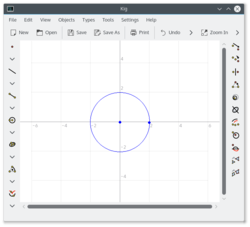| Kig | |
|---|---|
| | |
 | |
| Developer | KDE |
| Initial release | 2 August 2006 |
| Stable release | |
| Repository | |
| Written in | C++ (Qt) |
| Operating system | Unix-like, Mac OS X, Windows |
| Type | Interactive geometry software |
| License | GPL |
| Website | https://apps.kde.org/kig/ |
KIG is free and open-source interactive geometry software, which is part of the KDE Education Project. It has some facilities for scripting in Python, as well as the creating macros from existing constructions.


